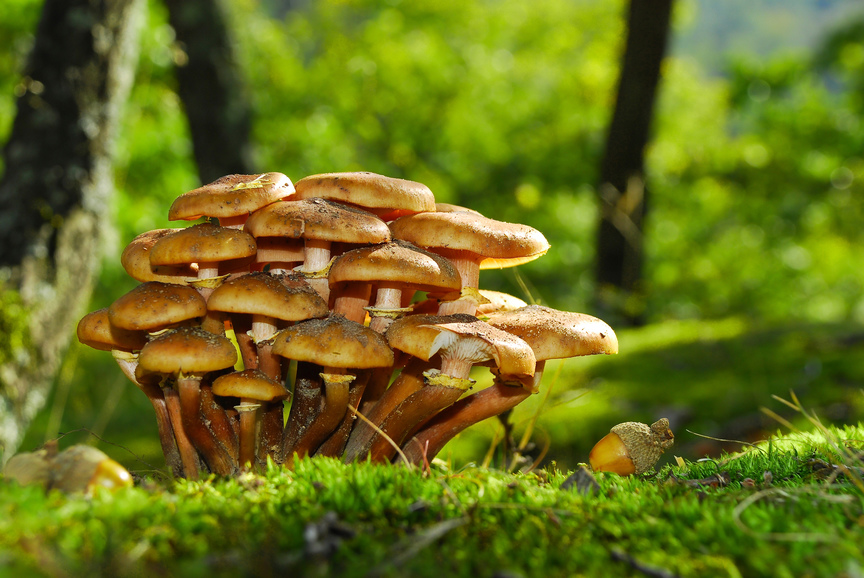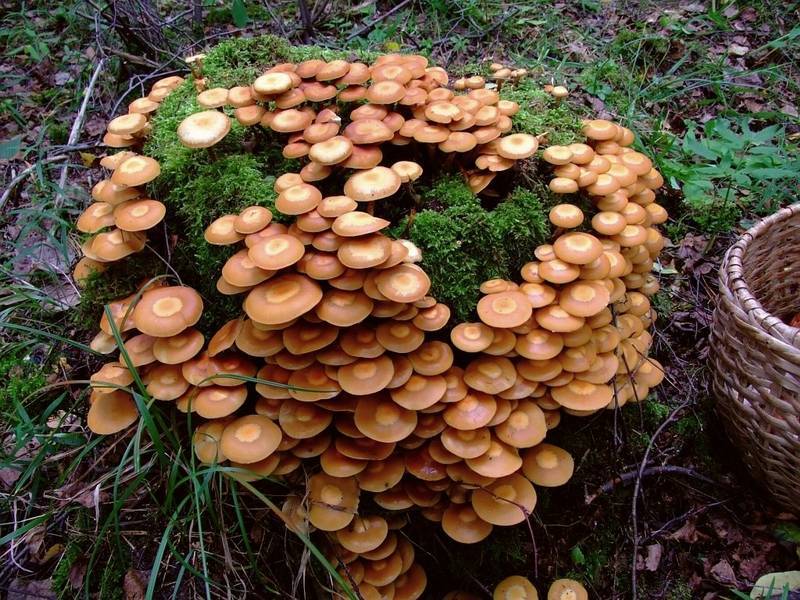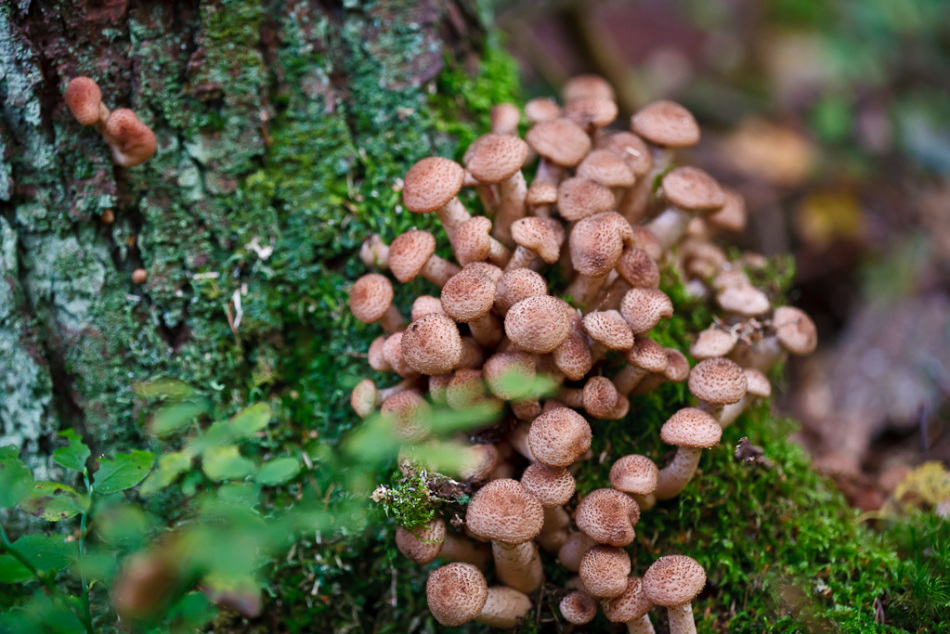What kind of mushrooms and when to collect in different regions/
Content
- Honey mushroom: description of mushroom variety
- When the first autumn mushrooms appear, when they begin to grow in the forest, in what month?
- Are autumn mushrooms growing in August, September, October, November?
- The mushrooms are honey agaric, Autumn, Assumption, winter: when do they begin to collect in the middle lane of Russia, Siberia, Belarus?
- Mushrooms of honey agarics: where are they growing, in which forests?
- Mushrooms of honey mushrooms grow under what and on what trees and stumps of what trees?
- How much time is honey mushrooms in the forest, at what speed?
- At what temperature are honey agarics grow?
- Do winter honey mushrooms grow after frost?
- What honey mushrooms can be collected?
- Video: OPYATA: Where, how and when to assemble?
Every fall, avid mushroom pickers are advanced in the search for delicious and fragrant mushrooms. In this material, you can find useful information about mushrooms. We hope it will come in handy.
Honey mushroom: description of mushroom variety
Mushrooms of honey mushrooms received their own name due to the fact that, as a rule, they grow on stumps. There are also honey mushrooms that grow in the meadows. If you transfer to Latin, the honey agaric is a “bracelet”, which has many beads.
- Nedata is edible mushrooms. Plus, they are quite tasty and contain a lot of beneficial substances in their own composition, for example, protein, fiber.
- These mushrooms tend to grow large families. It is not often possible to meet mushrooms growing alone.
- Open is a small mushroom. It has a height of no more than 15 cm. If these mushrooms did not grow large families, it would be difficult to distinguish them from ordinary poisonous mushrooms.

- The hat from the very beginning has a hemispherical shape. Over time, the edges of the hat are bent, recalling a miniature umbrella. The diameter of the upper part can be from 2 cm to 10 cm. The color of the hat is also different: from beige to reddish. But often there are yellow-red mushrooms ta.
- The pulp of all representatives of this mushroom is smooth, delicate, having a pale yellowish color. In addition, it is most often wet, as it collects moisture for the best viability. The mushroom flesh tastes tasty, giving raw wood.
- As for the leg, its length can reach up to 15 cm and have a color from light medium to brown. Very often there is a “skirt” on the leg of the mushroom, which connects the top and bottom of the mushrooms, plus it serves as an additional mount.
When the first autumn mushrooms appear, when they begin to grow in the forest, in what month?
You can meet in any period of the year. It all depends, first of all, on a variety of mushrooms and on weather conditions. Eg, autumn honey mushrooms They begin to grow around the end of summer, and you can see the last fungus in early December. Wrap -up honey agaricsAccordingly, they give an excellent crop in the cool period of the year, and the spring and those that grow in the summer begin to grow when the first heat comes.
Important: it is better to grow up in the fall, when it rains - it is at this time that they have enough moisture, therefore, the season of mushrooms is late autumn and early spring.
By the way, you probably noticed that when the rains pass, the number of mushrooms increases. This is due to the fact that these mushrooms simply adore moisture and they need very cheese soil to develop well. The temperature regime is not very important during the growth of mushrooms, since with the advent of cool weather one type of mushrooms grows, and with the advent of warm days - the other.

Autumn honey mushrooms have some distinctive characteristics:
- In order to germinate, many varieties of trees are suitable for mushrooms. Their approximate amount is 200. In some cases, honey mushrooms can sprout even in potatoes. At night, autumn mushrooms stand out beautifully: they are highlighted.
- The ideal conditions that are needed for the growth of mushrooms in the raw forest - stumps, for example, birch, aspen, as well as the dead wood of some trees.
- The diameter of the hay of the autumn nipple is approximately 16 cm, and the length of the legs is up to 10 cm.
Are autumn mushrooms growing in August, September, October, November?
Autumn honey mushrooms love to grow "flocks." They grow, as a rule, on stumps, but they can also be found on dead or sick trees, on healthy bushes, near roads, on cutting. The period when honey agaric is growing abundantly, short -term. As a rule, this happens within 14 days in early autumn or in late autumn.
Autumn honey mushrooms are divided into 3 categories:
- Autumn real
- Club -shaped or onionate
- Late form

Autumn honey mushrooms are very useful:
- There are a lot of copper and zinc in the autumn mushrooms. That is why they help to fight problems such as hair loss
- Mushrooms positively affect the gastrointestinal tract
- Squirrels that are part of the autumn mushrooms, slow down the development of oncology
- Powder, which is made from raw autumn mushrooms, destroys negative microflora and helps great with intestinal disorder
- Decoction and tincture prepared from the legs of mushrooms are recommended for liver diseases
- Substances that are part of the mushrooms increase the resistance of the human body and normalize the functionality of immunity
The mushrooms are honey agaric, Autumn, Assumption, winter: when do they begin to collect in the middle lane of Russia, Siberia, Belarus?
We are accustomed to calling mushrooms to be edible, plate mushrooms. Nedata is considered the most productive and collected mushrooms in the territory of the Russian Federation, Siberia and Belarus. As a rule, these mushrooms tend to complete the mushroom season.
In the central parts of Russia, honey mushrooms are often called the unusual name "Assumption". And all because the massive collection falls on a large church holiday, namely on the Assumption of the Blessed Virgin Mary. It is on August 28 that professional mushroom pickers go to the forest for mushrooms, which give good fruits for 3 weeks.

In many regions there is a second wave, when honey mushrooms are fruit. Again, it all depends on the climatic and weather conditions of a particular region. In those places, people gather autumn mushrooms before the end of October.
As for winter mushrooms, they are considered the most late. Frosts are not afraid of mushrooms. They can even freeze, turn into "lenses". But when they thaw, do not become too soft, do not lose their shape. The fruits of winter honey mushrooms can be collected in late autumn or in early December, at a time when snow is already lying around and other mushrooms cannot be found.
Mushrooms of honey agarics: where are they growing, in which forests?
Often, these mushrooms can be found in a ravine, on a stump, near the swamp or in raw impassable forest. They grow In the Northern Hemisphere Our planet, almost everywhere. There is really an exception - honey mushrooms cannot be found in those areas where there is an eternal permafrost.
- The yield depends on the important factor - the forest in which the mushrooms live. For example, summer mushrooms are found in coniferous forest. But only on the condition that if there is a mountainous area. They will never settle in other ways, since they will have little water.
- As for the deciduous forest, here you can easily collect the full baskets of mushrooms. Since only from one hemp you can pick up a lot of mushrooms, which are enough to prepare a soup, the second, snacks. In such a forest, all types of this category of mushrooms are found: winter, summer, autumn and spring.

- In a mixed forest, you can also notice honey agaric, but there are much less of them. It all depends on which area for living will choose a mushroom - more moisture, more in size to the family.
- In order for honey agarics to grow comfortably, they need a large amount of water, plus a warm climate. That is why mushrooms are not often found in meadows. Mushrooms do not tolerate direct rays of the sun, they like the shadow more.
But there are times when honey agarics still settle on stumps that are in the steppes. However, this phenomenon is extremely rare.
Mushrooms of honey mushrooms grow under what and on what trees and stumps of what trees?
The crop of mushrooms is primarily dependent on the tree under which they grow. Mushrooms adore deciduous trees, in particular birch and linden. But it should be remembered that this group of mushrooms loves to grow exclusively on dead trees and stumps. They can also occur under an oak, lena, acacia and other trees.
Now let's look at all the types of mushrooms and those trees on which they mainly grow:
- Spring and autumn tape He loves to grow most on deciduous trees. They use the trunks that are already damaged and have rot on the surface with a special preference. In the mountains, summer varieties can be met on fir trees or on stumps of fir trees.
- Nynat, which grow on coniferous breeds of trees, have a bitter taste and dark color. In a deciduous forest, summer honey mushrooms gathered from mid -spring to the end of summer. If the climate is favorable, then mushrooms grow without a break, giving us their nutritional fruits.

- Autumn mushrooms They are considered the most popular. Openka most of all likes to dwell on birch, birch stump, aspen, maple, oak. As a rule, autumn representatives choose those trees that begin to rot and get sick. Although in some cases, mushrooms choose a completely healthy tree. Especially like the autumn mushrooms of old birch trees, in which trunks are hung out, and swampy birch trees, having a large number of corn and stumps.
- Winter honey mushrooms They also love stumps of deciduous trees. The mushrooms are fruitful enough on very high and thickened logs of such trees as: aspen, poplar, willow. Winter representatives can even settle in gardens where fruit trees grow, gradually destroying their trunks. Preference is given: elm, poplar, Iva, Buka.
How much time is honey mushrooms in the forest, at what speed?
Autumn representatives grow faster than other mushrooms. They can gain full growth approximately in 7 days. But the speed of germination of mushrooms can still depend on some factors. For example, in order for the mushrooms to grow abundantly, they need perfect weather and moderate precipitation. In addition, the state of stump or wood also affects the growth. If the stump is very rotten, honey mushrooms grow faster. All because the pores are revealed through which air and moisture passes well.

Many professional mushroom pickers claim that autumn mushrooms can be collected through 3 days. That is, today to collect a group of mushrooms, and then return for a new batch in 3 days. Micologists, however, say that honey mushrooms grow in 1 day by 5 cm in height, while having a hat width of about 2 cm. After 3 days, these indicators change significantly, approximately 1.5 cm.
If we take wet autumn weather, then under such conditions they grow under such conditions 3 days after it has been rain. Scientists have found that mushrooms are most actively growing 1 day after precipitation. Also, fog affects the activity of the growth of mushrooms, which also saturates the soil with moisture.
At what temperature are honey agarics grow?
Autumn mushrooms know their price, therefore, they grow at a temperature of 8 degrees of heat to 13 degrees. If such a temperature drops at the end of summer or the beginning of autumn, then the main fruiting of the mushroom will move for this period of the year. If the temperature rises to 15 degrees of heat, then honey mushrooms can hide.
Do winter honey mushrooms grow after frost?
Autumn mushrooms may not survive frosts, but their winter brothers are not afraid of cold weather. They can be covered with a crust of ice, and after the onset of warm weather again to come to life and continue their growth. What is surprising after such a cold they always remain beautiful and elastic.
What honey mushrooms can be collected?
Nyx are edible and false. We will consider those that you can collect at any time of the year and prepare them for your own people.
- Autumn (real). The peak of mushroom reproduction falls on September for a month.
- Thick -legged. As a rule, they are considered saprophytes. They grow on rotten stumps or chased leaves. Adore beech and spruce. The growth season falls out at the end of summer and the end of autumn.
- Summer. These mushrooms grow with thick families on rotten deciduous trees of the northern latitudes of our country.
- Winter. Mushrooms grow on weak trees or on dead stumps. The most ideal climatic area is the northern part of the country.

- Spring. They grow, as a rule, tubers. You can meet from the beginning of summer until the end of autumn in small groups in places where there are rotten wood or fallen leaves.
- Rows of yellow-red. These mushrooms are considered conditional. They can only be collected young. But adult representatives have a bitter taste.
- Mucous membranes. Mushrooms are considered edible, but they almost have no taste and smell.
- Meadow. Eat mushrooms, belong to 4 categories. Only hats are used in food, because the legs are quite stiff.
- Garlic. They have a strong garlic smell. People use them dried, instead of seasoning. They can also boil and fry them. After thermal treatment is undergoing, they lose the specific smell of garlic.
- Large garlic. They grow in large families on fallen foliage, near the stump or rotten branches of beech.
You can read more information about the varieties of mushrooms here. We hope that the information will be useful to you.








A very interesting and informative article. I learned the differences between my beloved edible mushrooms from false poisonous mushrooms. Thank you very much!